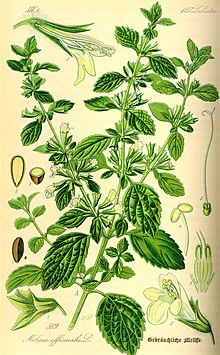Lemon balm
The second name, officinalis (Latin, 'of the shop'), originates from the use of the herb by apothecaries, who sold herbal remedies directly to their customers.[9] Melissa officinalis is native to south-central Europe, the Mediterranean Basin, Central Asia and Iran, but is now naturalized in the Americas and elsewhere around the world.[5] The leaves are harvested by hand in June and August in the northern hemisphere, on a day when the weather is dry, to prevent the crop from turning black if damp.[24] It was in the herbal garden of the English botanist John Gerard in the 1590s,[25][page needed] who considered it especially good for feeding and attracting honey bees.[26] Especially cultivated for honey production, according to the authors Janet Dampney and Elizabeth Pomeroy, "bees were thought never to leave a garden in which it was grown".[24] It was introduced to North America by the first colonists from Europe; it was cultivated in the Gardens of Monticello, designed by the American statesman Thomas Jefferson.[28] In traditional Austrian medicine, M. officinalis leaves have been prescribed as a herbal tea, or as an external application in the form of an essential oil.


Prostanthera melissifoliaConservation statusLeast ConcernIUCN 3.1Scientific classificationPlantaeTracheophytesAngiospermsEudicotsAsteridsLamialesLamiaceaeMelissaBinomial nameherbaceous plantmint familyflowersnativeperfumeryperennialeugenoltanninsterpenesMethyl HeptenoneCitronellalLinaloolGeranialGeranyl acetateCarophyllenebee balmMonardaapothecariessouth-central EuropeMediterranean BasinCentral Asiagerminatevegetativelytemperate zonescultivarslemon oilcitronella oilYieldsultravioletinfraredCarmelite WaterGerman pharmaciesornamental plantice creamspearmintpeppermint teacandiesfish dishesflavourgeraniolisomerscitralcaryophylleneSpreewald gherkinsGreeksRomansTheophrastusHistoria PlantarumMiddle AgesherbalistsphilosophersTudorsherbal gardenbotanistJohn Gerardhoney beesGardens of MonticelloThomas JeffersonNicholas CulpeperJupiterCancermelancholytraditional Austrian medicineherbal teaessential oilIUCN Red List of Threatened SpeciesUnited States Department of AgricultureUniversity of Maryland Medical CenterWayback MachineThe Wildlife TrustsBloomsburyChisholm, HughEncyclopædia BritannicaCulpepper, NicholasGerard, JohnJournal of EthnopharmacologyWikiversityAngelicaBay leafIndian bay leaf (tejpat)BorageChervilChivesgarlic / ChineseCicelyCoriander leaf / CilantroBolivianVietnamese (rau răm)CulantroCurry leafEpazoteHoja santaHouttuynia cordata (giấp cá)HyssopKinh gioi (Vietnamese balm)KkaennipLavenderLemon grassLemon myrtleLemon verbenaLimnophila aromatica (rice-paddy herb)LovageMarjoramMugwortMitsubaOreganoParsleyPerillaRosemarySavorySanshō leafSorrel